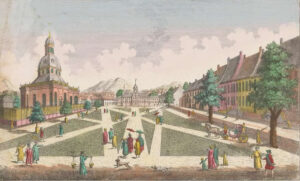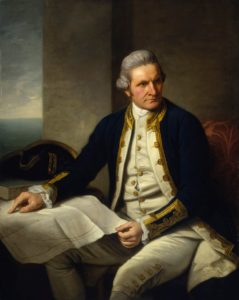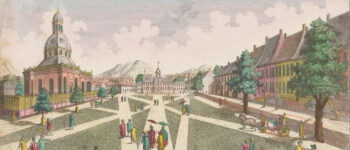1770: Christmas in Batavia
February 9, 2024
By AHNZ
 Over 250 years ago now, James Cook and the crew of HMS Endeavour completed the circumnavigation of North Island- demonstrating it is indeed an island. It’s good to know and we South Islanders are still very grateful for it!
Over 250 years ago now, James Cook and the crew of HMS Endeavour completed the circumnavigation of North Island- demonstrating it is indeed an island. It’s good to know and we South Islanders are still very grateful for it!
On 9 February, 1770, an important point had to be proven. That, Nieuw Zeeland, as the Dutch discoverers called it 123 years before, was not part of a great Southern Continent.
Navigation science had now demonstrated that Te Ika a Maui (The Fish of Maui,) as Maoris called the North Island, was right in so far as defining this as a distinct island of its own. This was probably the first time anyone had known it for hundreds of years if ever. Until now it had been a mythical belief.
Cape Palliser was passed and, on 9 February, 1770, “Cape Turnagain was recognised 7 leagues to the north-east. ‘I then called the officers upon deck and asked them if they were now satisfied that this land was an Island to which they answer’d in the affirmative and we hauled our wind to the Eastward.” Ref. p71 Begg (1970)
Endeavour then made a lap of the South Island, coming to a stop at Queen Charlotte Sound on 27 March. Then, it was time to head for home via New Holland (Australia.) Along the way the ship was badly beaten up, both hull and sail. Major repairs would be required if the Englishmen were to ever make it home again. Fortunately, there was somewhere they could go: Batavia.
The Dutch East India Company had been the boss of the East Indies for a long time now. In 1619 the Company had overcome an English fleet and the Islamic sultan, burning the capital of Jayakarta to the ground. It was replaced by a new model city, Batavia (these days it is again called Jakata, capital of Indonesia.) It is from here that Abel Tasman set off on pirate patrols and adventures of exploration which included the discovery of Nieuw Zeeland for the Company. So, Tasman wasn’t roughing it on the far side of the world so much as exploring his own back yard with the support of his fellow permanent residents.
On 7 October, 1770, Cook and his men limped in at Batavia. Back in civilisation again and at anchor, “with the dome of the great church of the town clearly visible.”¹ That would be, if I’m right, the church dome in the picture above.
Cook sought, and gained, permission from the Dutch Governor General Petrus Albertus van der Parra for the English ship to be repaired by the local experts. And, he even secured a loan to pay for the work from the local government, The Council of Indies. It would be costly but the ship received some much deserved, and essential, refitting for the long trip home.
“We arrived at Batavia in October, all in good health and high spirits. On our arrival at a European settlement we thought all our hardships at an end, but Providence thought proper to order it otherwise. The repairs the ship wanted caused a delay of near 10 weeks, in which time we contracted sickness, that here, and on our passage to the Cape of Good Hope, carried off about 30 of my people. ” – James Cook to John Walker, Historical Records of New Zealand, McNab (1914)
“The Endeavour was leaking twelve inches of water an hour; her main and false keels wer badly damaged; her sails in shreds and tatters; she was still punctured from the Barrier Reef; and her pumps were in dire need of repair…The Dutch told Cook it was a miracle that the ship had stayed afloat after the Barrier Reef.” p158 McFlynn (2011)

Batavia was no back-water but the major commercial center and port city for trade between Europe and Asia. Planned streets, canals, bridges, churches, markets, warehouses, and a central square were all long established. The Council of Indies that Cook had to deal with was the same body that had sent Able Tasman to explore New Zealand 130 years before. There were 20,000 people living within the city walls and 100,000 in the suburbs and beyond. Trade ships full of treasure flowed back and forth from this central hub. Ref. McFlynn (2011)
Tupaia and his servant Taiata had joined the crew the year before and now left the ship at the invitation of Joseph Banks and Daniel Solander who had rented a house in the city center. The transplanted Pacific Islanders “took to sightseeing with gusto” and were “bowled over by the sights and sounds of European civilisation.” Although this little private empire centered on Batavia had been there for over 150 years none of the Pacific Islander explorers, nor any Maoris in New Zealand, had any idea what was on their western doorstep.
Everyone was, of course, sworn to secrecy about Endeavour’s secret mission into the Tasman Sea. I’ll bet the Council of Indies would have loved to know what Cook had been up to and if he knew things they did not. The official story has always struck me unlikely that the Council sent Able Tasman all the way to Nieuw Zeeland only to turn away without exploring the land. Ref. 1642: Dutch Discovery of New Zealand, AHNZ
Maybe the Council sent a spy in the form of John Marra to infiltrate the crew? Being such a cosmopolitan city, Cook had no trouble finding fellow British sailors there and recruited 19 new crew. Marra was one of these and presented as Irish. Local Government at Batvia, however, claimed this man to be a Dane who had deserted one of their ships and needed to be handed back. Cook risked an international incident by refusing the demand. Perhaps by handing over Marra he would also have been handing over everything the man would have soon learned about his new shipmates and where they had come from? It is also true that Marra made a life out of jumping on and off ships, making the world his home. Cook later empathised with his Irish anarchist…”I never learnt that he had either friends or connections to confine him to any particular part of the world, all Nations were alike to him, where then can such a Man spend his days better than at one of these isles where he can injoy all the necessaries and some of the luxuries of life in ease and Plenty.” Ref. Beaglehole (1956)
Cook took Endeavour away from Batavia on 26 December. It should have been a refreshing and enriching Christmas for a crew making their home run. Instead, the crew was dying and 7 had already dead. Cook, Banks, and Solander were all badly ill along with everyone else. Tupaia and Taiata both died on Batavia. Had contractors not been repairing the ship the job could not have been done.
A stop at Panaitan Island for fresh provisions proved no help at all to fight the dysentry and malaria. On the way home 23 men died of disease. They arrived home at last on 12 July, 1771.
—
1 p157, Captain Cook Master of the Seas, Frank McLynn (2011)
Image ref. View of the town hall and the New Dutch Church in Batavia, (1755 – 1779,) rijksmuseum.nl
Ref. James Cook and New Zealand, A Charles Begg (1970)
Ref. On the Character of Captain James Cook, John Cawte Beaglehole (1956)
2 thoughts on "1770: Christmas in Batavia"
Leave a Reply
 Like Comment Share
Like Comment Share






Another great posting. I always wondered what happened in Batavia on their way home. You have thrown some great light on it. Cheers
I’d received the idea that Tasman and Cook were in a sort of ‘deep space’ exploration mission far far away from home. But really Batavia was right there and full of history we don’t talk about. The Dutch had a whole lot going on before ‘we’ took over. I love that map with Dutch names….which I’ll retroactively add now…